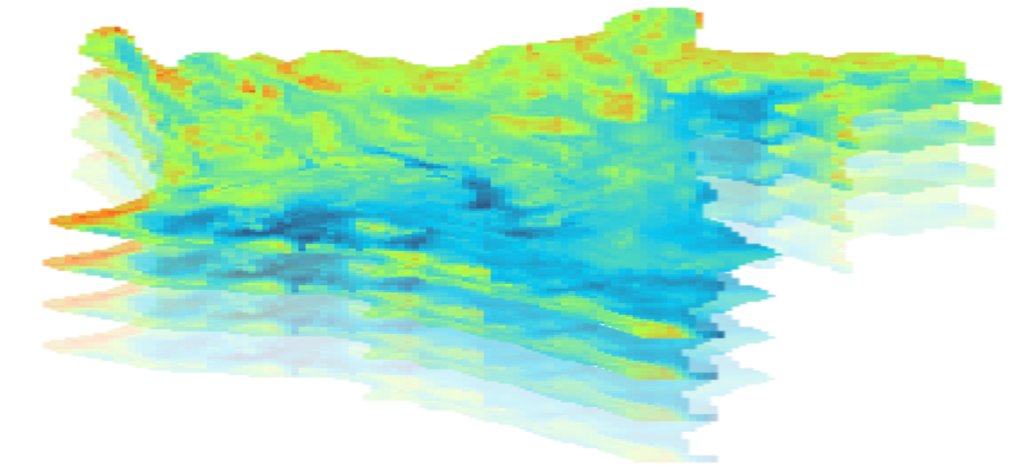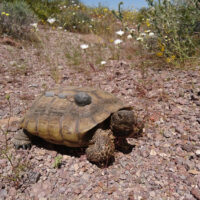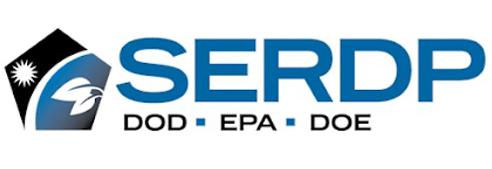
An interdisciplinary approach to understanding environmental stressors and management impacts on Mojave desert tortoise populations will help resource managers better conserve tortoises and increase military readiness on Department of Defense (DoD) lands.
Project Description:
To recover populations of the federally ‘Threatened’ and declining Mojave desert tortoise (Gopherus agassizii), land managers can benefit from better understanding of stressors influencing population dynamics and how improved management might benefit populations. This may be particularly important for the DoD, which manages land across a considerable portion of the species’ range and is tasked with ensuring both military readiness and the conservation of federally protected species and landscapes. In this context, the T&E Lab and our project cooperators at the University of Nevada, Reno, US Geological Survey, and the US Fish and Wildlife Service are implementing a truly interdisciplinary approach to improve military and multi-jurisdictional landscape management of the Mojave desert tortoise across its range.

Objective
This project will seek to fill critical knowledge gaps and advance scientific understanding of the population response of a Department of Defense (DoD) relevant species, the federally threatened Mojave desert tortoise (Gopherus agassizii; hereafter ‘tortoise’), to varying levels of exposure from multiple stressors, over time and across the range of the species. In this context, the core objectives are to:
- Work with managers from multiple jurisdictions to employ a structured approach to co-production, building a shared understanding of the priority factors affecting tortoise populations, characteristics of exposure scenarios that respond to management decision spaces, and key information gaps;
- Compile existing, regional data on anthropogenic, climate, and other environmental stressors on tortoise populations. Deploy advanced machine learning modeling techniques to accurately map range-wide trends and patterns (historical and future) of priority environmental stressors identified in Objective 1;
- Use > 35 years of empirical data and a spatially explicit Bayesian hierarchical modeling framework to estimate range-wide trends (historical and future) in tortoise meta-population dynamics, and the cumulative influence of multiple stressors quantified in Objective 2, under varying exposure scenarios;
- Design, engineer, and deploy an interactive, web-based tool to allow managers and other stakeholders access to historical, near-real time, and likely future information on tortoise population status and the individual or cumulative effects of multiple stressors, under varying exposure scenarios.
Technical Approach
Despite substantial investments by DoD and other agencies in tortoise management and conservation, the species remains in perilous decline across much of its range. The project team will connect and build from various tortoise research efforts that, to date, have been independently implemented within and among multiple management jurisdictions. There are unique opportunities to develop and include data on previously unquantified stressors, and to complement or crosswalk existing monitoring tools. Novel hypotheses related to the cumulative effects of multiple stressors on range-wide tortoise meta-population dynamics under a variety of management-relevant exposure scenarios will be tested, and the project team will produce user-friendly tools that result in actionable science. Guided by early and continuous engagement of installation and natural resource managers, and drawing on a software engineering perspective and highly efficient, cutting-edge computational resources, this project will produce statistically robust models of historical, current, and future stressors on tortoise populations that can be easily accessed and flexibly evaluated in a single, web-based interface. The products of the ‘one stop shop’ approach will be designed to: inform installation species status assessments; complement impact evaluation and mitigation driven conservation strategies; and support installation and cross-jurisdictional efforts to develop cost-effective conservation and recovery options, including estimating how conservation actions might efficiently offset effects of stressors, such as impacts of military activities.
Benefits
This project will directly support DoD mission readiness and flexibility by informing desert tortoise conservation and related decision-making efforts across installations and adjacent ownership in the 32 million-acre Mojave Desert ecoregion. The area contains several DoD military facilities and service units, as well as extensive adjacent federal public lands. The project team has engaged specific, key collaborators at several DoD installations and adjacent management agencies (e.g., U.S. Fish and Wildlife Service, Bureau of Land Management), who are the expected end-users of the products. Beyond addressing important knowledge gaps for a priority DoD species, the project will enable the development of cohesive, range-wide management strategies aimed toward more effective ecosystem and priority species recovery initiatives and partnerships between agencies. The truly interdisciplinary, integrative approach will provide a fresh perspective to comprehensive and adaptive management of desert tortoise populations, grounded in cutting-edge science and the delivery of knowledge and tools that DoD requires for mission success in a rapidly changing world.
Funding and partnerships:
With funding from DoD’s Strategic Environmental Research and Development Program (SERDP), we are working with managers from multiple jurisdictions to employ a co-production approach to understand factors influencing tortoise populations, including stressors, management actions, and key uncertainties. We will use machine-learning techniques to map range-wide trends in priority stressors on populations, which will be used as covariates in a Bayesian hierarchical population model estimating historical, contemporary, and future impacts on tortoise population dynamics. Results will be visualized in a publicly accessible, continuously updating web tool that will provide land managers with maps and other information describing how different stressors and management scenarios might influence tortoise populations over space and time. Core partners include University of Nevada, Reno, U.S. Fish and Wildlife Service Desert Tortoise Recovery Office, and the U.S. Geological Survey.

Project workflow and timeline:
Understand the Needs of Managers | 2022-2023
Identify information gaps and needs at DoD installations and neighboring jurisdictions
Specify the individual and synergistic effects of key stressors on tortoise populations
Define management-relevant scenarios for conservation and recovery

Derive Stressor Layers | 2023-2024
Leverage existing spatial data on population stressors and across the species’ range
Derive new data and models describing stressors using AI and machine learning
Develop model outputs that automatically update as new data becomes available

Model Population Response to Stressors | 2023-2024
Work with partners to compile over six decades of field data on tortoises
Evaluate effects of multiple stressors within a Bayesian statistical framework
Model and map population demography under different exposure scenarios

Visualize Impacts | 2024-2025
Iterate with managers and stakeholders to improve model outputs and target their application
Develop a dynamic, web-based application to explore trends in populations over space and time

Key Outcomes | 2025-2026
Robust, range-wide models and maps of the dynamic response of Mojave desert tortoise populations to multiple stressors under various exposure and management scenarios (historical, contemporary, future)









